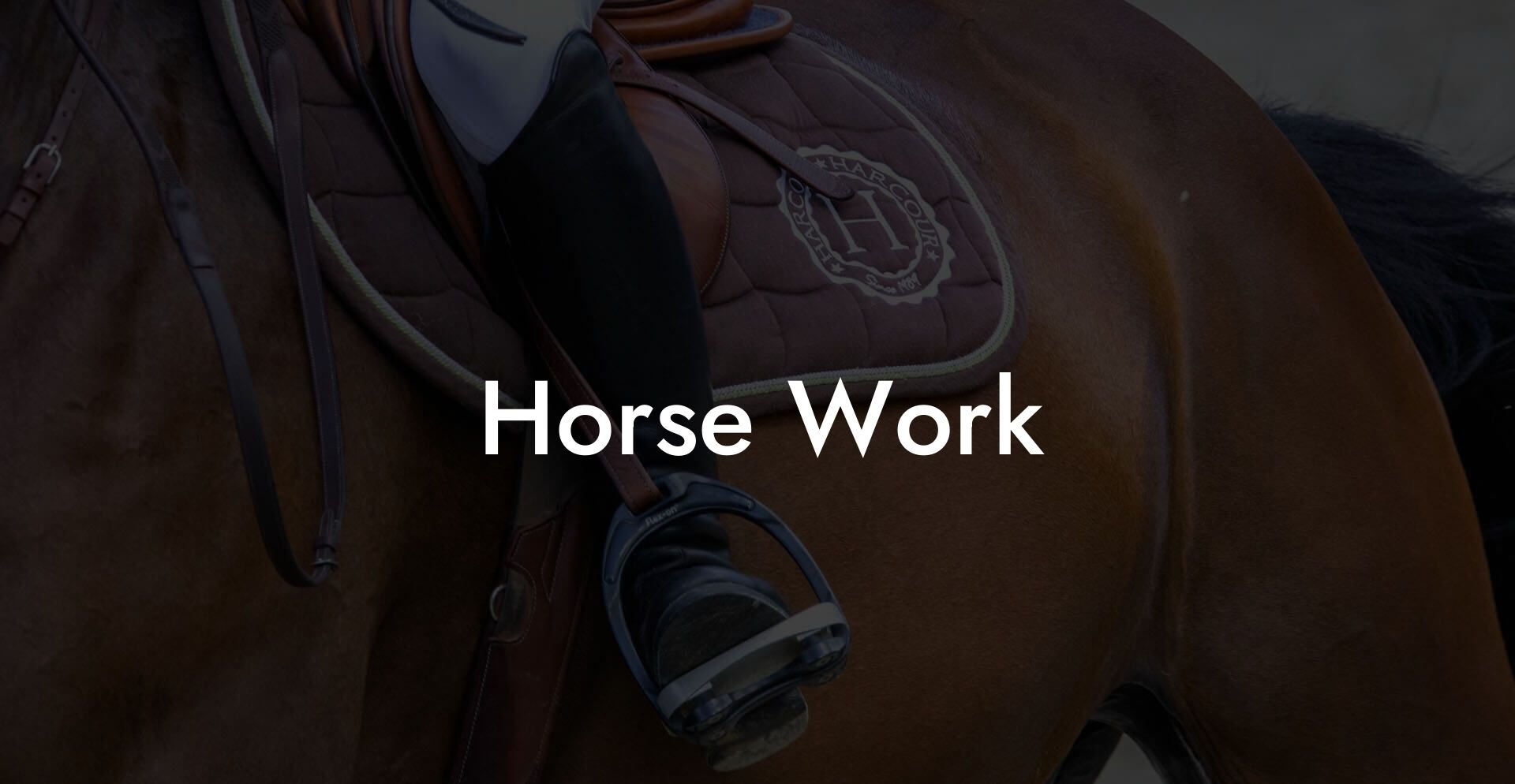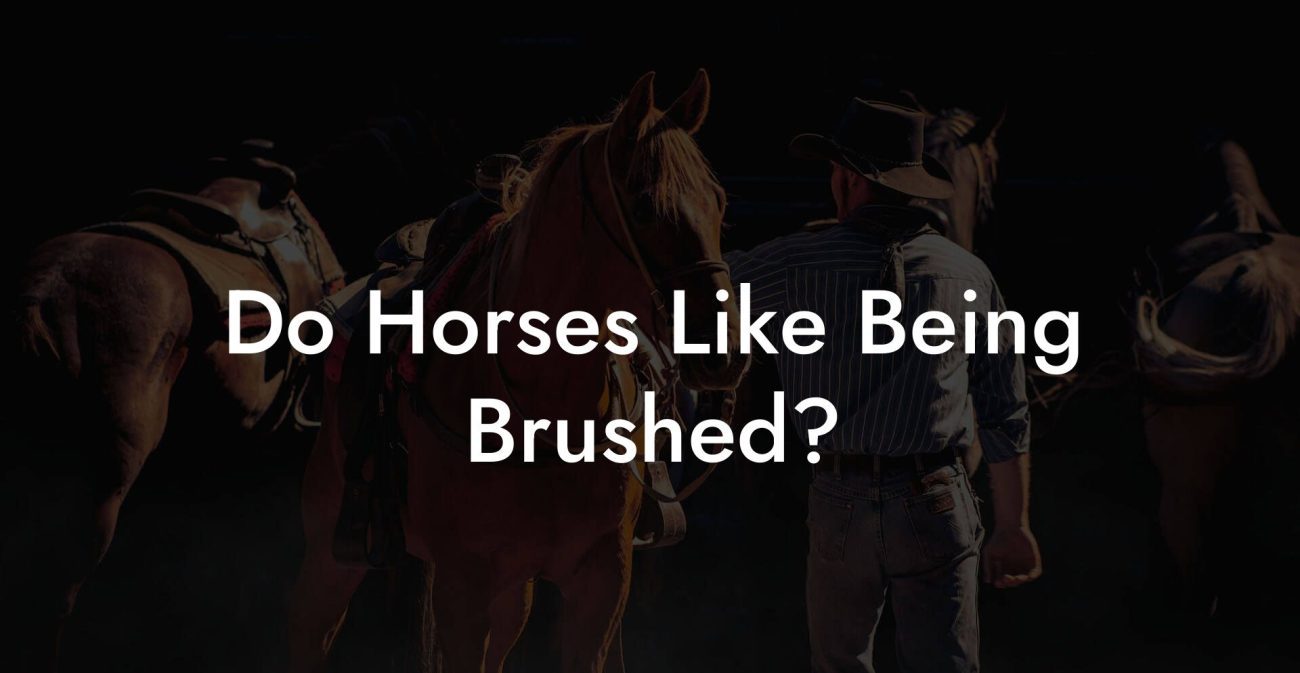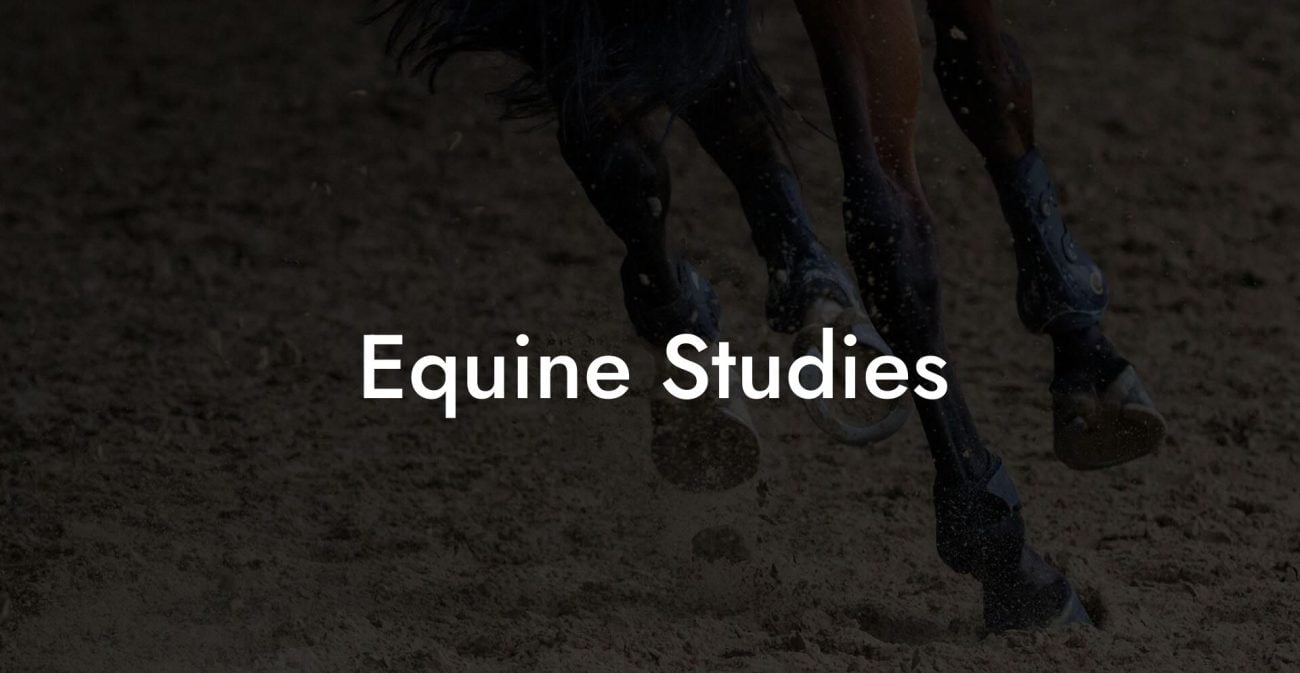The crack of dawn finds you dusting off the saddle, your trusty steed pawing the ground with excitement, and you, ready to dive headfirst into the vibrant, ever-evolving world of horse work. Whether you’re an urban equestrian or a country bumpkin at heart, embracing horse work means immersing yourself in a realm where tradition meets innovation. Here, caring for your horse isn’t just a chore, it’s an art form, a science, and yes, a lifestyle that resonates with the spirit of Gen-Z and the free-spirited millennial. Get ready to discover practical tips, insider secrets, and hands-on techniques that will have you and your four-legged buddy trotting into a new era of equine care.
Quick Links to Useful Sections
- Understanding Horse Work: The Heart of Equine Care
- Crafting Your Daily Routine: Grooming, Feeding, and Exercise
- Morning Grooming: Where Science Meets Art
- Nutritional Essentials: Fueling Your Equine Powerhouse
- Exercise and Training: Sculpting Strength and Agility
- The Importance of Consistency in Your Horse’s Routine
- Hands-On Techniques: Mastering the Tools of Horse Work
- Grooming Tools: From Brushes to Hoof Picks
- Hoof Care: Keeping Your Equine Athlete on Track
- Bodywork and Massage: The Relaxation Factor
- Nutritional Essentials: Fueling Your Equine Companion
- Understanding the Basics of Equine Nutrition
- Customized Dietary Plans for Performance and Recovery
- Building a Connection: Communication, Trust, and Training
- Understanding Equine Body Language
- Incorporating Modern Training Techniques
- Health and Safety: Preventive Care and Veterinary Guidance
- Regular Health Check-Ups
- Emergency Preparedness and First-Aid
- Tools and equipment: Must-Have Accessories for Horse Work
- Essential Grooming and Health Tools
- Stable Management Technology
- Resources and Community Support: Your Next Steps in Horse Work
- Frequently Asked Questions About Horse Work
- Your Journey to Empowered and Effective Horse Work
Understanding Horse Work: The Heart of Equine Care
Horse work is more than traditional riding lessons or weekend trail rides. It’s an all-encompassing approach to caring for an animal that has been humanity’s loyal companion for centuries. Whether you’re tackling the daily routine of grooming, monitoring your horse’s health, or fine-tuning their training regimen, each element of horse work plays a vital role in nurturing a deep and meaningful bond.
At its core, horse work is about balancing exercise, nutrition, mental stimulation, and relaxation. It’s a holistic practice that involves not only physical tasks like cleaning the stable or clipping the hooves but also forging an emotional connection and establishing trust. For those who are passionate about equine care, every moment spent with your horse is an invitation to explore new techniques, integrate modern technology, and revisit time-tested traditions.
Today’s guide provides a roadmap to mastering horse work, combining expert advice, scientific insights, and a touch of humor to create an engaging resource for anyone eager to elevate their equine care game.
Crafting Your Daily Routine: Grooming, Feeding, and Exercise
A successful horse work routine is built on consistency, care, and a keen eye for detail. As the sun rises, it’s time to get hands-on with your equine companion, structuring a daily routine that keeps your horse healthy and happy.
Morning Grooming: Where Science Meets Art
The day starts with grooming, a ritual that’s as much about bonding as it is about cleanliness. Visualize this: gentle strokes along your horse’s mane, a soft ear scratch, and a thorough brushing that not only eliminates dust and dirt but also calms your horse’s nerves. Grooming is a vital component of horse work that improves blood circulation, relieves muscle tension, and paves the way for a trusting relationship.
Modern equine enthusiasts are embracing techniques from traditional grooming herbs to high-tech grooming kits. Not only do you need a good curry comb and a quality brush, but you might also consider integrating innovative products like organic hoof cleaners and eco-friendly shampoos to ensure your horse reflects the best of nature and science.
Nutritional Essentials: Fueling Your Equine Powerhouse
Horse work is more than just physical labor, it’s about ensuring every aspect of your horse’s life is in harmony, and nutrition plays an indispensable role. From high-quality hay to supplements that support joint health and muscle recovery, every morsel matters. Think of your horse as an athlete: the right mix of carbohydrates, proteins, and essential vitamins ensures optimal performance and longevity.
With sustainability and organic produce trending among millennials and Gen-Z, many equestrians are handpicking locally sourced feed and supplements that reduce chemical dependency while boosting your horse’s natural vitality. Always consult with a veterinarian or equine nutritionist to tailor the diet to your horse’s specific needs.
Exercise and Training: Sculpting Strength and Agility
A well-rounded exercise routine is at the heart of effective horse work. This isn’t just about long rides through the pasture, it’s about integrating routines that keep your horse both physically and mentally agile. Incorporate a mix of trotting, cantering, and even ground exercises that challenge their balance and coordination.
Many riders today are turning to interval training methods, incorporating flatwork drills, agility courses, and even resistance training to ensure their horses stay lean, strong, and responsive. The goal is to develop not only physical endurance but also a heightened level of body awareness, which is crucial for advanced riding disciplines or competitive sports.
The Importance of Consistency in Your Horse’s Routine
The secret sauce of effective horse work lies in consistency. Just as a musician practices scales daily, a horse flourishes when its daily routine is both predictable and stimulating.
Horses are naturally creatures of habit. They thrive on routines that build trust and security. Stick to a regular schedule that includes feeding, exercise, and rest, and you’ll notice improved behavior, enhanced performance in training sessions, and a deeper, more intuitive communication channel with your horse.
Moreover, consistent care helps in early identification of any changes in behavior or health. Whether it’s a slight shift in gait or an unusual reaction to a grooming tool, noticing the small details comes easier when you’re fully engaged in a regular, hands-on routine.
Young riders and seasoned professionals alike have found that blending routine with a touch of spontaneity, like an unexpected trail ride or a new grooming technique, can keep your horse excited and mentally stimulated while maintaining a solid routine.
Hands-On Techniques: Mastering the Tools of Horse Work
Getting your hands dirty is part and parcel of true horse work. Beyond the basics of grooming and feeding, there’s a whole toolkit of techniques that can transform the way you care for your horse. Let's dive into some of the most effective hands-on methods that combine modern science with traditional wisdom.
Grooming Tools: From Brushes to Hoof Picks
Investing in quality grooming tools is non-negotiable. Start with a set of brushes that cater to different parts of your horse’s body, a soft bristle brush for sensitive areas and a stiffer one for clearing out tangles. Hoof picks are essential to get rid of debris lodged in the hooves, preventing bacterial infections and ensuring optimal movement.
Many riders now opt for ergonomic handles and washable materials that make the cleaning process both effective and environmentally friendly. Incorporate detanglers and shine sprays to keep your horse looking sleek, and don’t forget the grooming mitts that help distribute natural oils throughout the coat, boosting overall skin health.
Hoof Care: Keeping Your Equine Athlete on Track
Hoof care in horse work demands a balance of scheduled maintenance and attention to detail. This involves regular cleaning, careful examination for cracks or splits, and periodic visits from a farrier. Hoof health is a reflection of your overall management practices, and neglect can lead to lameness or more serious conditions.
Modern techniques include using digital thermometers to check for inflammation and applying specialized hoof conditioners that blend traditional remedies with contemporary science. These practices ensure your horse’s hooves remain robust, flexible, and well-protected against varying terrains.
Bodywork and Massage: The Relaxation Factor
Just as athletes benefit from a massage, so do horses. Incorporating regular massage sessions as part of your horse work routine can help alleviate muscle tension, improve circulation, and enhance overall recovery after strenuous activities. Whether you’re learning a few basic massage techniques or consulting a professional equine masseuse, the aim is to make bodywork a natural part of your husbandry.
Consider integrating acupressure points and deep tissue techniques into your routine. The relaxation that comes from a well-executed massage not only improves muscle recovery but also deepens the trust between you and your horse.
Nutritional Essentials: Fueling Your Equine Companion
When it comes to supporting the vigorous lifestyle of your horse, feed is your most powerful ally. Horses have unique nutritional needs that require a balance of energy, protein, vitamins, and minerals. High-quality forages, grains, and specially formulated supplements can make all the difference in your horse's performance and longevity.
Understanding the Basics of Equine Nutrition
A horse’s diet should primarily consist of high-fiber forage such as hay or pasture grass. This not only aids in digestion but also promotes dental health by encouraging natural chewing motions. Supplementing with grains like oats or barley can provide additional energy for active horses, while specialized feed formulas often include a blend of vitamins and minerals tailored to your horse’s workload.
Today’s equine nutrition intersects with trends in sustainable and organic feeding practices. Many modern horse owners are turning to locally sourced, non-GMO feeds to ensure their horses receive food that’s as healthy as it is eco-conscious.
Customized Dietary Plans for Performance and Recovery
No two horses are exactly alike, and understanding your horse’s individual needs is crucial in the realm of horse work. Performance horses may require higher caloric intake and additional protein to support muscle recovery, while older horses might need diets geared toward joint care and lower overall energy content.
Collaborating with an equine nutrition specialist can help you fine-tune your horse’s diet. By analyzing factors such as exercise intensity, age, and overall health, you can create a nutritional blueprint that ensures peak performance and maximum recovery.
Building a Connection: Communication, Trust, and Training
Beyond the physical aspects of horse work, one of the most rewarding components is the deep, trusting bond you forge with your horse. Equine communication is a subtle art, non-verbal cues, body language, and gentle guidance all come into play.
Understanding Equine Body Language
Horses are sensitive creatures that communicate predominantly through body language. A slight ear flick or a change in posture can reveal how your horse is feeling. Observing these cues is critical in adapting your training and care techniques, ensuring that your horse feels safe, understood, and ready to engage.
Many modern trainers blend conventional methods with an intuitive approach that emphasizes empathy and mutual respect. This methodology resonates particularly well with younger equestrians, merging technology with the art of subtle communication.
Incorporating Modern Training Techniques
Today’s horse work integrates classical training with innovative methods including clicker training, positive reinforcement, and even apps that track performance metrics. These tools not only streamline training but also help in understanding your horse’s progress dynamically.
Remember, every training session is an opportunity to build a stronger connection. Celebrate small victories, stay patient with setbacks, and keep the atmosphere relaxed, after all, the best training happens when both you and your horse are in sync.
Health and Safety: Preventive Care and Veterinary Guidance
Horse work isn’t just about day-to-day tasks, it’s also about preparing for the unexpected. Preventive care and regular veterinary visits are critical for keeping your horse in optimal condition. Routine vaccinations, dental checks, and parasite control are just a few of the essential practices that ensure your horse stays healthy throughout the year.
Regular Health Check-Ups
Scheduling periodic visits with your veterinarian is non-negotiable. These check-ups allow for early detection of potential issues before they escalate into major health crises. During these visits, vets typically evaluate your horse's body condition, listen to the respiratory system, and check for any signs of pain or discomfort.
Preventive care also extends to hoof health, where regular farrier visits can prevent lameness and other foot-related problems. Integrating a preventative approach into your horse work routine underscores the importance of long-term well-being over short-term fixes.
Emergency Preparedness and First-Aid
Even with the best care, accidents can happen. As part of your horse work regimen, familiarize yourself with equine first-aid practices. Stock your stable with essential supplies like bandages, antiseptics, and cooling packs. Knowing how to handle minor injuries can make a significant impact on your horse’s recovery time and overall health.
Engage with online forums, local equestrian clubs, or even mobile apps that offer step-by-step guidance on emergency response. Staying informed is the first step toward effectively managing unexpected situations.
Tools and equipment: Must-Have Accessories for Horse Work
From grooming kits to modern wearable devices, the right tools can elevate your horse work from routine to remarkable. Investing in quality equipment not only makes daily tasks easier but also ensures your horse experiences the best in comfort and safety.
Essential Grooming and Health Tools
A well-equipped toolkit for horse work should include a variety of brushes, hoof picks, and mane combs designed to suit different coat types. High-quality shampoos and conditioners, specifically formulated for equine skin, help maintain a healthy, shiny coat.
In addition, digital tools are making waves in equine care. Tracking devices, smart halters, and wearable sensors can monitor your horse’s vital signs, activity levels, and even sleep patterns. These modern marvels provide real-time data that can inform adjustments to exercise routines, dietary plans, and overall care strategies.
Stable Management Technology
Advances in technology have revolutionized stable management. Automated feeding systems, climate-controlled stables, and even remote monitoring cameras ensure your horse is safe, comfortable, and well-fed, even when you’re off the clock. These tools not only enhance efficiency but also give you peace of mind knowing that every aspect of your horse’s environment is operating at peak performance.
Embracing these modern innovations within your horse work routine reflects a broader trend among Gen-Z and millennial equestrians, balancing tradition with technology to create a holistic and responsive care environment.
Resources and Community Support: Your Next Steps in Horse Work
In the rapidly evolving world of horse work, no one is truly an island. Connecting with fellow enthusiasts, experienced trainers, and equine health professionals can significantly enrich your journey. The modern equestrian community is vibrant, accessible, and incredibly supportive, offering everything from online forums and social media groups to local riding clubs and workshops.
Consider joining platforms like equine care podcasts, Instagram accounts dedicated to horse work, and YouTube channels that offer DIY grooming tutorials. These resources are not only educational but also help in staying motivated when the going gets tough. Networking with like-minded individuals will provide fresh insights, robust support, and opportunities to share your own journey.
Local stables, veterinary clinics, and community centers often host events, clinics, and training sessions tailored to the needs of both beginners and seasoned professionals alike. Embracing these opportunities will help you keep up with the latest trends in equine care, refine your techniques, and embed yourself in a community that celebrates every triumph on the trail.
Whether you’re looking to refine a technique, troubleshoot challenges, or simply find a group of friends who share your passion for horse work, these resources and community networks are your next essential step in this exciting journey.
Frequently Asked Questions About Horse Work
Below are some of the most frequently asked questions about horse work, designed to address the common queries and concerns of budding and experienced equestrians alike.
1. What exactly does “horse work” encompass?
Horse work includes every aspect of caring for your horse, from daily grooming, feeding, and exercise routines to advanced training, stable management, and preventive health care. It’s a holistic approach that values both physical and emotional well-being.
2. How important is a daily routine in horse work?
Consistency is the backbone of successful horse work. A daily routine helps build trust, predictability, and an attentive eye for any changes in your horse’s behavior or health, ultimately leading to a stronger bond.
3. What nutritional strategies should I consider for my horse?
Focus on a balanced diet that primarily consists of high-quality hay or pasture grass, complemented by grains, vitamins, and minerals tailored to your horse’s activity level and overall health. Consulting with an equine nutritionist is highly recommended.
4. How often should I schedule a veterinary check-up for my horse?
Regular veterinary appointments, typically biannual or annual, are essential for preventive health care. However, if any unusual behavior or symptoms occur, contact your veterinarian immediately.
5. Can modern technology improve the way I manage horse work?
Absolutely. Technological tools such as wearable sensors, automated feeders, and digital monitoring devices play a significant role in today’s horse work, offering insights into your horse’s health and activity that traditional methods may overlook.
6. What are some effective training methods for building trust with my horse?
Modern training techniques like clicker training, positive reinforcement, and non-verbal communication strategies are excellent for building trust while ensuring your sessions remain fun and productive.
7. How do I choose the right grooming tools for my horse?
Choose grooming tools based on your horse’s coat and specific needs. A good set should include soft brushes for delicate areas, firm brushes for removing dirt and tangles, and hoof picks to keep the hooves clean and well-maintained.
8. Where can I find community support and resources on horse work?
Online forums, social media groups, local equestrian clubs, and events organized by stables or veterinary centers are excellent sources of community support and learning. They’re a great way to stay up-to-date with the latest in equine care.
9. What preventive measures are crucial in horse work?
Preventive measures include regular veterinary check-ups, a consistent grooming routine, proper nutrition, and emergency preparedness. These practices help safeguard against common equine ailments and injuries.
10. How can I balance traditional methods with modern technology in horse work?
The best approach is to blend time-honored practices like hands-on grooming and regular farrier visits with innovative technology such as digital health monitors and smart stable equipment. This integration ensures that you benefit from both reliability and cutting-edge advancements.
Your Journey to Empowered and Effective Horse Work
Embarking on the journey of horse work means embracing a lifestyle where every brush stroke, every perfectly portioned meal, and every training session is a step toward a deeper, more fulfilling equine relationship. It’s about empowering both you and your horse to thrive in a world that honors the rich history of equine care while boldly stepping into the future.
By blending time-honored traditions with modern innovations, you create an environment where your horse not only survives but thrives, embodying strength, resilience, and grace. From the early morning grooming rituals to the late-night stable checks, each moment is a testament to the art of care that defines true horse work.
Remember that every day spent nurturing your horse is a day spent investing in a lasting partnership. It’s a relationship built on trust, mutual respect, and a passion for excellence. Whether you’re an aspiring equestrian or a seasoned pro, embracing these principles will transform everyday chores into moments of joy, fulfillment, and creative expression.
Step into the arena of horse work with confidence and curiosity. Explore new techniques, integrate supportive technology, and connect with a vibrant community of equestrians who share your commitment to excellence. Your path to empowered equine care starts here, celebrate the journey, honor the tradition, and welcome every challenge as an opportunity to grow.
Harness the passion, energy, and innovative spirit of today’s world to redefine what horse work can be. Your horse is not just an animal; they are your partner, your confidant, and a living testament to the beauty of a life lived in harmony with nature. Enjoy the ride, both the literal and the metaphorical journey towards holistic, heart-felt equine care.













